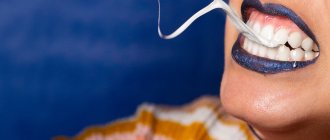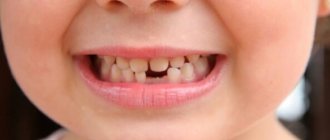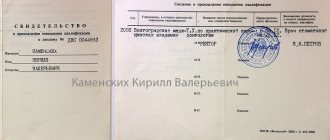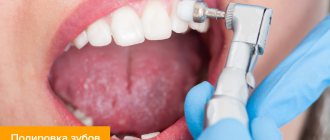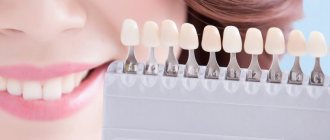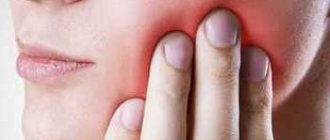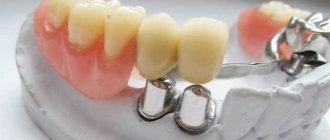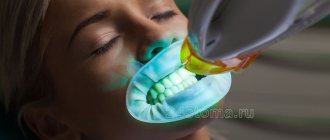Everyone dreams of a beautiful and snow-white smile. But with age, unfortunately, one has to forget about the beauty of teeth.
Poor nutrition, smoking, excess coffee or tea stain our teeth an unpleasant yellowish color.
The listed factors also contribute to the development of tartar on the surface of the teeth, which does not make the smile attractive and the teeth healthy.
With the development of medicine, such problems are far behind us..
For your information! Sandblasting teeth cleaning is one of the procedures that will help cope with difficulties of this kind.
What is sandblasting teeth cleaning?
Professional cleaning is a comprehensive preventive measure.
It helps prevent the development of various dental diseases, improve the health of gums, dental tissue and oral cavity .
Sandblasting is one of the mandatory stages of professional tooth enamel whitening.
The main goal of the procedure is to eliminate dense pigmented and mineralized plaque on teeth and tartar.
This cannot be done at home with just a toothbrush.
Pros of cleaning
You should know! As a result of this procedure, the tooth surface becomes smooth, smooth, shiny and, importantly, becomes several shades lighter.
In addition to the purely aesthetic side of the matter, this type of cleaning also solves dental problems.
Regular scaling prevents the development of dental caries and related complications that can lead to tooth loss.
You should not eat or drink for the first hour after cleansing.
For 48 hours after the procedure, the patient must adhere to a “white” diet.
You should not consume foods and drinks that have a coloring effect.
Among them are beets, carrots, cherries, blueberries, mulberries, coffee, tea, Coca-Cola, wine and other drinks with dyes. You should not smoke for two days!
Which is better Air Flow or ultrasound
Ultrasonic cleaning or Air flow?
Ultrasound techniques and Air flow belong to the category of preventive hygiene measures aimed at eliminating hard plaque from the surface of teeth. These procedures must be performed at least twice a year to prevent the development of caries, gum disease, etc.
- Ultrasonic teeth cleaning involves removing plaque and tartar using a special dental scaler. Ultrasonic vibration waves act precisely on the boundary that directly separates the stone and the enamel. After crushing, small particles are washed away with a powerful stream of water.
Ultrasound also works well against bacteria that are in the interdental space. On average, manipulation takes from 20 to 40 minutes. Ultrasound does not require anesthesia, unless the patient has very sensitive teeth.
Competitive advantages of ultrasonic cleaning:
- absolute safety, since the method is non-contact and does not involve the use of aggressive chemicals;
- helps to reliably remove hard deposits that cannot be removed by regular daily cleaning using a paste, even with large abrasive particles;
- the ultrasonic scaler removes subgingival stone well in pockets, thereby preventing the development of inflammatory processes in soft tissues;
- returns the natural shade to the teeth, because after manipulation the enamel becomes lighter by 1 - 2 tones (due to plaque removal).
- Air flow teeth cleaning is indicated for removing soft, pigmented plaque. "Air Flow" is a special sandblasting device produced by a Swiss company that effectively removes soft plaque of bacteria. The method is relevant when the so-called “plaque plaques” have not yet had time to become hard and turn into full-fledged tartar.
The essence of the method is as follows: an abrasive mixture (soda and water) comes out of the thin tip of the device, the jet has an effect on the plaques, which fall off, while the tooth surface is well polished and acquires radiance.
Competitive advantages of Air flow:
- painless – the procedure is performed without anesthesia;
- safety, since soda crystals do not damage the enamel;
- the technique allows you to remove soft plaque on the surface of the teeth and in the gaps between dental units;
- relevant for patients with prosthetic structures, crowns, implants.
Among the nuances of ultrasound, we note contraindications for people who have orthopedic structures, dentures, or implants in the oral cavity, since vibrations can disrupt the integrity of the elements. Cleaning is also not recommended in the first 3 months of pregnancy.
As for the nuances of the procedure, Air flow is not suitable for removing hard plaque and does not cope with subgingival deposits. Also, such cleaning does not fight microorganisms that cause inflammatory processes in the oral cavity.
What should be done more often – Air flow or ultrasonic cleaning?
Ultrasound is indicated approximately once every six months. You can perform “Air Flow” every three months, until the soft plaque has time to transform into a hard one. The duration of the procedures in both cases is the same - up to 40 minutes.
What is more affordable: Air flow or ultrasound?
The cost of the procedures differs insignificantly. Ultrasound costs less – from 2500 rubles. The price of Air Flow in Moscow is approximately 3,000 rubles. Anyway. The investment will pay off in the health of your teeth!
To summarize: which teeth cleaning is better, ultrasonic or Air flow?
When choosing between ultrasound or Air flow, you need to understand. What goals are you pursuing? If you simply remove stains from smoking, pigments from coffee, tea and coloring foods, Air flow will do. If you need to remove hard plaque, prevent caries and gingivitis, ultrasound is needed.
It is best to determine which teeth cleaning is better - mechanical or ultrasonic, and also which teeth cleaning will be more effective - laser or ultrasound, can be determined by an experienced dentist. The 32 Dent dental network employs experienced hygienists who will assess the condition of your oral cavity, select a gentle cleaning method and provide proper care for your teeth and gums.
If you have a problem similar to that described in this article, be sure to contact our specialists. Don't diagnose yourself!
Why you should call us now:
- We will answer all your questions in 3 minutes
- Free consultation
- The average work experience of doctors is 12 years
- Convenient location of clinics
Single contact phone number: +7
Make an appointment
Execution Sequence
The total duration of the procedure is about half an hour - an hour , it all depends on the condition of the oral cavity.
Stay up to date! It is not complicated, but requires special equipment and qualified medical personnel.
Sandblasting is carried out in several stages:
- Consultation with a doctor . During the procedure, the dentist will determine which method will be used to remove tartar. This will become possible only after examining the patient’s oral cavity. The choice of cleaning method will depend on the condition of the tooth surface and the degree of its neglect.
- Removal of subgingival and supragingival tartar using ultrasonic, manual, mechanical or combined methods.
- Direct sandblasting teeth cleaning . It is performed using a special device that delivers a stream of water under high pressure to the surface, which contains cleaning agents (a powder mixture of synthetic soda bicarbonate). After such manipulation, the tooth surface becomes uneven and has a porous structure. To avoid even more contamination of your teeth in the future, you need to take a number of actions.
- Polishing the surface of tooth enamel with special brushes and pastes that give them ideal smoothness and shine.
- Applying an antiseptic bandage to the gums and fluoride varnish to the treated tooth surface. This is to reduce the sensitivity of tooth enamel.
Many patients are concerned about the pain that may occur during such cleansing.
You should immediately reassure impressionable people: the procedure is absolutely painless .
Sometimes some patients talk about unpleasant sensations, but this is purely individual: everyone has their own pain threshold.
Types and differences of professional teeth cleaning
There are various ways to clean your mouth professionally. Each option has advantages and disadvantages. The choice of technique is made by the dentist.
Ultrasonic
It is performed using a special device - an ultrasonic scaler. The working element of the device is equipped with a nozzle that performs oscillatory movements at an ultrasound frequency of 25-50 kHz. The effect is enhanced by supplying an antiseptic solution or water through the nozzle. Deposits are removed under the influence of cavitation.
This method does not damage the enamel. When treating the oral cavity with an antiseptic, pathogenic bacteria are destroyed. The effectiveness is so high that it is possible to cope even with supra- and subgingival stones. The patient does not feel pain after brushing his teeth.
Laser
Removal of mineral deposits and plaque from the surfaces of the oral cavity is carried out under the influence of a laser beam. The liquid evaporates from them, as a result of which the destruction process begins. Peeled particles are removed with a stream of water supplied under high pressure.
The cost of the service is higher than alternative methods, due to the use of expensive equipment.
Sandblasting
Cleaning is performed using Air Flow equipment. The device even copes with old deposits. The main condition is that the coating must be soft. Air Flow does not remove tartar. The process of sanitation of the mouth involves the use of a special attachment, a mixture containing a fine abrasive, and a fixing gel. This method is used with caution in cases of increased sensitivity of the gums.
Chemical
The essence of the procedure is to apply a special gel containing hydrogen and acid to the teeth. During aging of the product, hard and soft deposits are destroyed under the influence of chemicals.
The method is painless and effective. But the interdental areas are poorly treated.
Mechanical
Sanitation is carried out using brushes and highly active pastes. This method requires more time than alternative options. But the result is high. However, in the process of mechanical impact with brushes, the risk of damage to the enamel increases. For this reason, specialists rarely resort to such cleaning.
Advantages and disadvantages of sandblasting
Sandblasting cleaning of dental surfaces has a number of advantages :
- Excellent appearance of tooth enamel : they become significantly lighter, acquire smoothness and shine.
- The procedure is a good preventive measure for the development of caries, gum inflammation, and periodontal disease.
- The enamel remains intact after the procedure .
- Absence of pronounced pain.
- Relative duration of preservation of the obtained result .
- No complications in the future.
- The pressure of water with a cleaning agent is able to clean even the most difficult to reach places in the oral cavity.
- The procedure is not considered expensive.
- Cleaning is considered completed in one session.
Remember! Like any procedure, sandblasting has certain disadvantages:
- The need to keep your mouth open for 20 - 30 minutes .
- Salty taste of the emulsion used for processing.
- Preservation of enamel sensitivity for several days (2 – 3 days) after the procedure.
- Following restrictions on food and habits for some time.
- There may be irritation of the palate and tongue .
- Sometimes patients experience bleeding gums.
Only after weighing all the pros and cons can you make the right decision about the need for sandblasting.
Reference! Modern dentistry offers an alternative method of drilling: instead of a drill, ultrasound, laser, and in some clinics, sandblasting are sometimes used.
Prices for professional cleaning
A specialist can tell you the exact price for sandblasting teeth during your initial consultation. The cost of the service is influenced by the following factors:
- Presence of dental diseases that need to be treated.
- The number of teeth that need to be cleaned.
- Complexity and volume of pollution.
- Cost of materials and equipment used.
- Qualification of the specialist performing the cleaning.
What are the contraindications?
Like any medical procedure, sandblasting teeth has its contraindications.
It is not recommended for the following categories :
- Children.
- Patients with acute respiratory viral infections, acute respiratory infections, HIV, hepatitis, tuberculosis, asthma, stomach ulcers.
- Allergy sufferers (in particular, to soda and some medications). It would be wiser to let the dentist know before the procedure if the patient is allergic to anything. Most likely, the procedure will not be contraindicated, but the doctor must be aware.
- Persons with wounds in the oral cavity.
- For those whose gums are inflamed.
- Pregnant women with a threat of miscarriage.
Indications and contraindications
The main indications for performing oral hygiene with a sandblasting machine are:
- Preparation before treatment of dental diseases. Sanitation is performed before prosthetics, implantation or orthodontic treatment, as well as after therapy.
- Inflammatory diseases and bleeding gums.
- Heavy plaque on the teeth and the presence of stones.
- The need to clean dental structures (implants, braces, etc.).
- Changes in the color of tooth enamel (yellowing, darkening) due to external factors: eating large amounts of food with natural or artificial colors (coffee, soda, wine, etc.). The procedure also allows you to get rid of yellow teeth caused by smoking.
- Dense or irregularly spaced teeth, or crooked teeth. Between tightly spaced or twisted teeth, plaque forms much faster and turns into tartar.
- Having bad breath.
- The appearance of a brown or yellow stripe on the tooth at the edge of the gum.
Contraindications include:
- Diseases:
- Diabetes.
- Arrhythmia.
- Hepatitis.
- Bronchial asthma and other respiratory diseases.
- Having an allergic reaction to soda or components of polishing mixtures.
- Colds, flu and other viral diseases.
- Tuberculosis.
- HIV.
- Disturbances in the structure or structure of dental tissues:
- Malocclusion.
- Increased sensitivity of teeth.
- Pathological abrasion of tooth enamel.
- Demineralization of dental units.
- Presence of implants in the patient’s body:
- Pacemaker.
- Titanium dental post implants.
- Other contraindications:
- During pregnancy and breastfeeding.
- The patient's age is under 12 years.
Reviews
Below are some reviews. If you have something to say, leave your feedback in the comments below the article, it will be useful to our readers.
Vladimir Perepechko, Krasnodar.
I don’t smoke, but for several years now I have been a real “coffee addict”, capable of drinking several cups in a row.
After drinking your favorite drink, a persistent yellow plaque has formed on your teeth that cannot be removed with a toothbrush.
A friend recommended sandblasting. I didn’t put off going to the clinic until later.
I expected to spend a long time in it, but it was all over in 40 minutes: conversation with the doctor, ultrasonic teeth cleaning, sandblasting procedure, grinding.
None of the above caused me any noticeable discomfort.
Vasilisa Gorbatko, Kazan.
I heard about sandblasting teeth cleaning and mentally compared it to brushing teeth with an emery tool.
But she still dared, because she really wanted to impress her colleagues. But the process turned out to be completely painless and short-lived.
The doctor only needed one attachment; I had a special tube in my mouth to remove saliva and fluid.
Finally, the dentist cleaned my teeth with a special paste and polished their surface. And now - the snow-white smile belongs to me!
Air Flow cleaning: how it works
As we have already said: the device creates a mixture of compressed air, water and particles of a fine abrasive substance (sodium bicarbonate). This mixture is applied to the teeth under high pressure. Particles of sodium bicarbonate hit the plaque, as if knocking it off the enamel, and the water-air spray washes away the abrasive particles and fragments of the removed plaque.
When using this method, damage to tooth enamel is completely eliminated due to the size and special shape of sodium bicarbonate granules. In addition, for patients with damaged or particularly sensitive enamel, it is possible to use the “Air-Flow Soft” powder version, which contains an abrasive with a smaller particle size.
However, the manufacturer guarantees that when using Air-Flow Classic powder, which has a standard abrasive particle size, you will not get scratches on the surface of your teeth. This is achieved by giving the abrasive particles a rounded shape, carried out using special equipment.
Air flow whitening –
Air flow teeth whitening – occurs by removing from the tooth surface absolutely all surface contaminants that can change the color of the tooth (bacterial and pigment plaque). However, you must understand that Air flow cannot change the natural color of the hard tissues of teeth - the latter can only be achieved through a chemical teeth whitening procedure.
Thus, Air flow whitening occurs only by removing external contaminants from the surface of the teeth - almost exactly the same as abrasive-type whitening toothpastes do. It is only natural that such pastes will be much less effective than professional cleaning or chemical bleaching.
Sandblasting teeth whitening in dental clinics in Moscow
- President prestige
- 6th street New Gardens, building 2, bldg. 1
- +7 (499) 938-… show all
- Mon, Tue 9:00–21:00; Wed 9:00–18:00; th-
3.6 ratings: 8
- Orthodontist complex
4.6 ratings: 5
- 32 den
4.2 ratings: 11
- Agami
4.2 ratings: 11
- Avantis
4.2 ratings: 11
- Lemon
4.2 ratings: 4
- Clinic on Pokrovka
4.5 ratings: 6
- Smile
3.9 ratings: 10
- Arm clinics
3.5 ratings: 6
- European Dental Center
3.6 ratings: 7
- Stomach Avenue
4.5 ratings: 10
- Cosmetic dent
3.8 ratings: 5
Further
Air flow: reviews
Air flow teeth cleaning – the reviews are extremely positive, and patients, speaking about the shortcomings, only remember pain in the neck area of the teeth during the procedure (24stoma.ru). The temperature of the water-air spray is slightly lower than body temperature, and therefore people with increased sensitivity of the enamel may well experience moderate discomfort, which, however, is quite tolerable.
Advantages of Air flow –
- High-quality cleaning of tooth enamel, root surfaces in periodontal pockets - from bacterial and pigmented plaque, even in the spaces between teeth.
- An amazing feeling of freshness in the mouth after the procedure, as well as the smoothness of the tooth enamel.
- The procedure causes less discomfort than ultrasonic cleaning, which may be important for people who are afraid of dental procedures.
- Air-flow and Air-flow Perio allow you to remove the bacterial film with endotoxins from the surface of the roots in periodontal pockets. This is very important in patients with periodontitis, and allows, in combination with basic periodontal treatment, to achieve stable remission of the disease.
Contraindications and disadvantages of Air flow –
- The method allows you to remove only pigment plaque and very small hard dental deposits. To remove massive deposits before the AirFlow procedure, the dentist will be forced to perform ultrasonic cleaning on you.
- The method cannot be used during an active inflammatory process in the gums, but can be carried out after the inflammation subsides.
- You cannot carry out AirFlow if you have bronchial asthma or asthmatic bronchitis, because... there is a high probability of developing bronchospasm. We hope that our article: Cleaning and whitening AirFlow cost reviews was useful to you!
Sources:
1. Add. professional
, 2. Based on personal experience as a periodontist, 3. National Library of Medicine (USA), 4. American Academy of Periodontology (USA), 5. https://www.ems-dental.com/.
